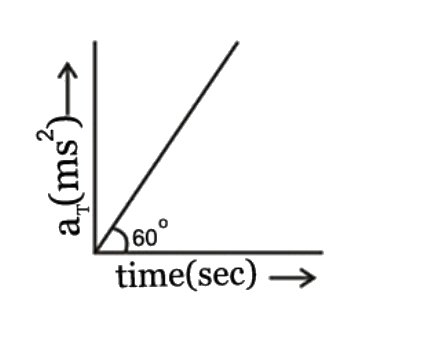The initial velocity of a particle is u (at t = 0) and the acceleration f is given by f=αt. Which of the following relation is valid?
v=u+αt3/2
v=u+αt22
v=u+25αt5/2
v=u+3αt5/2
To solve the problem step by step, we need to analyze the given information and derive the relationship between the velocity, initial velocity, and acceleration.
Step 1: Understand the given information
We are given:
- Initial velocity of the particle at t=0 is u.
- The acceleration f is given by the equation f=αt.
Step 2: Relate acceleration to velocity
We know that acceleration is the time derivative of velocity. Therefore, we can write:
f=dvdt
Substituting the expression for acceleration, we have:
αt=dvdt
Step 3: Rearranging the equation
We can rearrange the equation to separate the variables:
dv=αtdt
Step 4: Integrate both sides
Now, we will integrate both sides. The left side integrates with respect to v and the right side with respect to t:
∫dv=∫αtdt
This gives us:
v=αt22+C
where C is the constant of integration.
Step 5: Apply the initial condition
We know that at t=0, the velocity v is equal to u:
u=α(0)22+C
This simplifies to:
u=C
Step 6: Substitute the constant back into the equation
Now we can substitute C back into our equation for v:
v=u+αt22
Conclusion
Thus, the valid relation is:
v=u+αt22
We are given:
- Initial velocity of the particle at t=0 is u.
- The acceleration f is given by the equation f=αt.
We know that acceleration is the time derivative of velocity. Therefore, we can write:
f=dvdt
Substituting the expression for acceleration, we have:
αt=dvdt
We can rearrange the equation to separate the variables:
dv=αtdt
Now, we will integrate both sides. The left side integrates with respect to v and the right side with respect to t:
∫dv=∫αtdt
This gives us:
v=αt22+C
where C is the constant of integration.
We know that at t=0, the velocity v is equal to u:
u=α(0)22+C
This simplifies to:
u=C
Now we can substitute C back into our equation for v:
v=u+αt22
Thus, the valid relation is:
v=u+αt22
Topper's Solved these Questions
- MOTION IN A STRAIGHT LINEBOOK - AAKASH INSTITUTE ENGLISHCHAPTER - MOTION IN A STRAIGHT LINEEXERCISE - ASSIGNMENT (SECTION - B)
33 Videos
- MOTION IN A STRAIGHT LINEBOOK - AAKASH INSTITUTE ENGLISHCHAPTER - MOTION IN A STRAIGHT LINEEXERCISE - ASSIGNMENT (SECTION - C)
36 Videos
- MOTION IN A STRAIGHT LINEBOOK - AAKASH INSTITUTE ENGLISHCHAPTER - MOTION IN A STRAIGHT LINEEXERCISE - EXERCISE
29 Videos
- MOTION IN A PLANEBOOK - AAKASH INSTITUTE ENGLISHCHAPTER - MOTION IN A PLANEEXERCISE - Assignement section -J (Aakash Challengers Questions)
7 Videos
- MOTION IN STRAIGHT LINEBOOK - AAKASH INSTITUTE ENGLISHCHAPTER - MOTION IN STRAIGHT LINEEXERCISE - Assignment (SECTION - J)
2 Videos
Similar Questions
The initial velocity of a particle is u (at t = 0) and the acceleration f is given by f = at. Which of the following relation is valid?
View SolutionThe intial velocity of a particle is u (at t=0) and the acceleration is given by f=at. Which of the following relations is valid ?
View SolutionThe initial velocity of a particle is x ms−1 (at t=0) and acceleration a is function for time, given by, a= 6t. Which of the following relation is correct for final velocity y after time t?
View SolutionThe intial velocity of a particle moving along x axis is u (at t = 0 and x = 0) and its acceleration a is given by a = kx. Which of the following equation is correct between its velocity (v) and position (x)?
View SolutionThe velocity of a particle is given by v=12+3(t+7t2). What is the acceleration of the particle?
View SolutionVelocity of a particle is given as v=(2t2−3)m/s. The acceleration of particle at t = 3s will be :
View SolutionIf the velocity of the particle is given by v=√x and initially particle was at x=4m then which of the following are correct.
View SolutionA particle moves along the x-axis obeying the equation x=t(t−1)(t−2), where x is in meter and t is in second
a. Find the initial velocity of the particle.
b. Find the initial acceleration of the particle.
c. Find the time when the displacement of the particle is zero.
d. Find the displacement when the velocity of the particle is zero.
e. Find the acceleration of the particle when its velocity is zero.
View SolutionA particle is projected in such a way that it follows a curved path with constant acceleration →a. For finite interval of motion. Which of the following option (s) may be correct :
→u= initial velocity →a= acceleration of particle →v= velocity at t>0
View SolutionTangental acceleration of a particle moving in a circle of radius 1 m varies with time t as shown in figure (initial velocity of the particle is zero). Time after which total acceleration of particle makes an angle of 30∘ with radial acceleration is

View Solution
